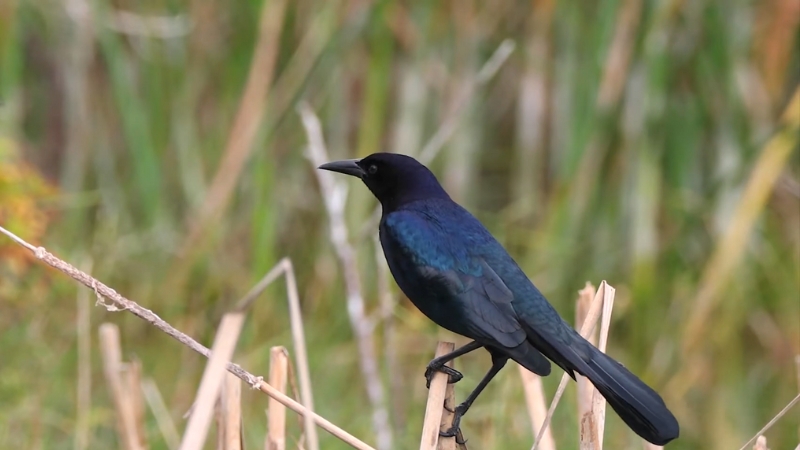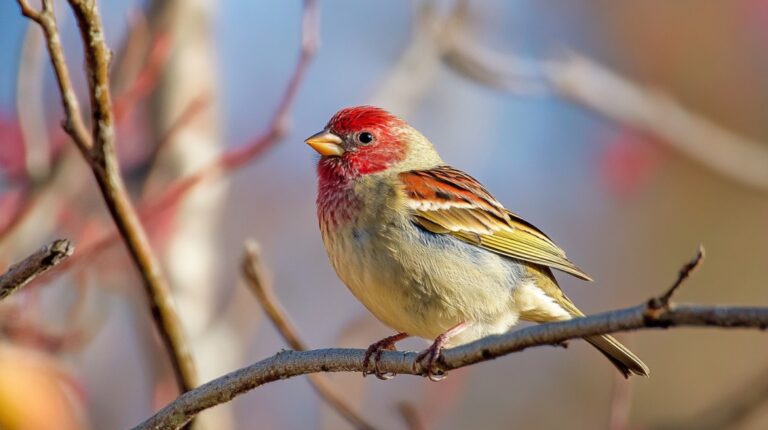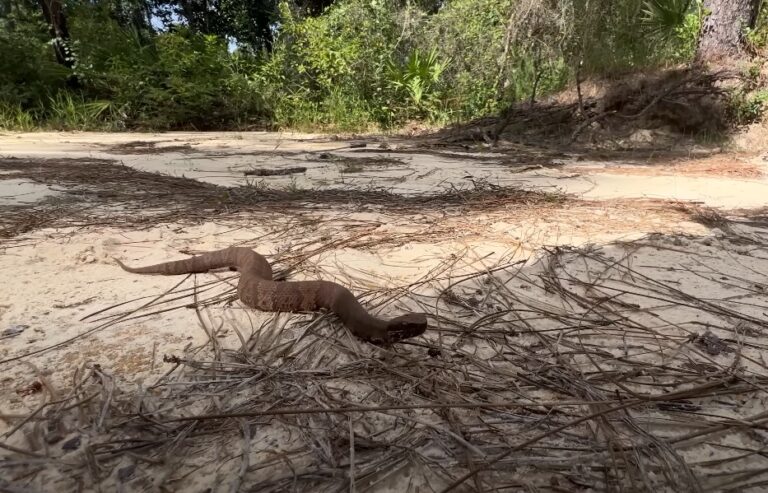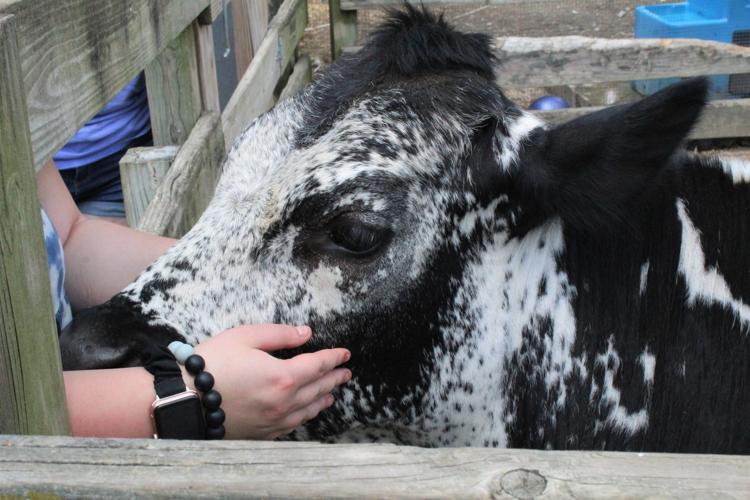Ever looked out your window and spotted a sleek black bird strutting around like it owns the place? Or maybe you’ve seen a huge swirling flock dancing in the sky and thought, “What the heck are those?”
Black birds are pretty much everywhere in Virginia, but telling one from another? That’s a whole different game.
From the bold Red-winged Blackbird flashing its fiery shoulder patches to the clever, loudmouth American Crow plotting who knows what, these birds are way more interesting than they might seem at first glance.
Some are backyard regulars, while others stick to marshes or coastlines. And yeah, a few are even troublemakers that don’t actually belong here.
So whether you’re just curious about the birds that keep raiding your feeder or you’re trying to figure out who’s making all that noise at sunrise, I’ve got you covered.
Table of Contents
Toggle1. Red-winged Blackbird (Agelaius phoeniceus)
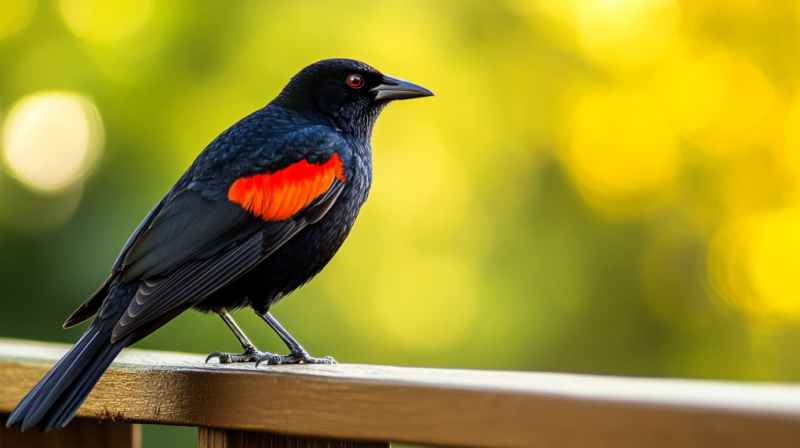
Red-winged Blackbirds are easily recognizable by the striking red and yellow shoulder patches on the males, which contrast sharply against their otherwise jet-black plumage.
Females are quite different, appearing brown and heavily streaked, with a bit of yellow near the bill.
These birds are most commonly seen perched on cattails or tall reeds in wetlands and marshy areas, where males aggressively defend their territories during the breeding season.
Their distinctive, rich musical song, “conk-la-ree,” is a common sound in spring as they sing to attract mates and ward off intruders.
Females build nests low in dense marsh vegetation like cattails and sedges, constructing sturdy cups of woven plant material. Outside of the breeding season, Red-winged Blackbirds are frequently found in open grasslands, farm fields, and pastures, forming large flocks that sometimes include other blackbird species such as grackles and cowbirds.
They are opportunistic feeders, primarily consuming seeds from grasses and weeds but also including insects in their diet, particularly during breeding when extra protein is needed to support growing chicks. Despite their territorial nature, they often congregate in massive numbers during migration or in winter roosts.
Trait
Description
Scientific Name
Agelaius phoeniceus
Size
7-9 inches (17-23 cm)
Wingspan
12-16 inches (30-40 cm)
Diet
Seeds, insects, grains
Habitat
Wetlands, marshes, grasslands
Song
Rich, musical “conk-la-ree”
Lifespan
Up to 15 years
Conservation Status
Least Concern
2. European Starling (Sturnus vulgaris)
European Starlings have iridescent black plumage with a glossy green and purple sheen. In winter, they develop white spots and their beak turns from yellow to dark. They are slightly smaller than American Robins and have a sleek, compact body shape.
Starlings are highly adaptable and thrive in urban areas, agricultural fields, and residential neighborhoods. They are often seen around parks, lawns, and city centers.
European Starlings are omnivorous, feeding on insects, fruits, seeds, and even food scraps. Their versatile diet helps them thrive in diverse environments.
Starlings are known for forming massive flocks called murmurations, creating mesmerizing patterns in the sky. They are aggressive and often outcompete native bird species for nesting sites.
Females lay 4-6 eggs in nests built in cavities or man-made structures. Incubation lasts about 12 days, and chicks fledge approximately three weeks after hatching.
Trait
Description
Scientific Name
Sturnus vulgaris
Size
8-9 inches (20-23 cm)
Wingspan
12-16 inches (30-40 cm)
Diet
Insects, fruits, seeds, scraps
Habitat
Urban areas, fields, parks
Song
Varied whistles and clicks
Lifespan
2-3 years (up to 15 in captivity)
Conservation Status
Least Concern
3. Brown-headed Cowbird (Molothrus ater)
Male Brown-headed Cowbirds are glossy black with a rich brown head, while females are plain brown with subtle streaking on the belly. Both sexes have thick, conical bills ideal for seed eating.
These birds prefer open areas like grasslands, brushy thickets, and woodland edges. They are also commonly seen in pastures, orchards, and residential areas.
Cowbirds feed primarily on seeds and grains, but they also consume insects, especially during breeding when protein is essential.
Brown-headed Cowbirds are notorious brood parasites, laying their eggs in the nests of other bird species. They don’t build nests or raise their young but rely on host parents to do the job.
Females lay 1-2 eggs per nest, often choosing different host species. The incubation period is around 10-12 days, and the host bird raises the cowbird chick, often at the expense of its own offspring.
Trait
Description
Scientific Name
Molothrus ater
Size
7-8 inches (18-20 cm)
Wingspan
12-15 inches (30-38 cm)
Diet
Seeds, grains, insects
Habitat
Grasslands, pastures, urban areas
Song
Low gurgling “glug-glug-glee”
Lifespan
Up to 16 years
Conservation Status
Least Concern
4. Downy Woodpecker (Dryobates pubescens)
@annshineann #woodpecker #downywoodpecker #bird #birds #wildlife #wildlifephotography #tree #park #forest #sing #nature #ohio #usa ♬ original sound – annshineann
Downy Woodpeckers are among the smallest and most common woodpeckers in Virginia, easily recognized by their black-and-white plumage and small red patch on the back of the male’s head.
They are found in deciduous forests, parks, and suburban gardens, where they often visit bird feeders for suet, sunflower seeds, and peanuts.
These agile climbers forage on tree trunks and branches, pecking away to extract insects like beetles, ants, and caterpillars.
They are also known to consume berries and seeds, especially during colder months. Their drumming and high-pitched whinnying calls are common sounds in wooded areas.
Nests are excavated in dead trees or limbs, where females lay 3-8 eggs, which hatch after about two weeks.
Both parents take turns feeding the young until they fledge at around 20-25 days old.
Known for their friendly nature and frequent visits to backyard feeders, Downy Woodpeckers are a beloved sight for many bird enthusiasts.
Trait
Description
Scientific Name
Dryobates pubescens
Size
6-7 inches (15-18 cm)
Wingspan
10-12 inches (25-30 cm)
Diet
Insects, seeds, suet
Habitat
Deciduous forests, parks, backyards
Song
High-pitched whinny
Lifespan
4-6 years
Conservation Status
Least Concern
5. Dark-eyed Junco (Junco hyemalis)
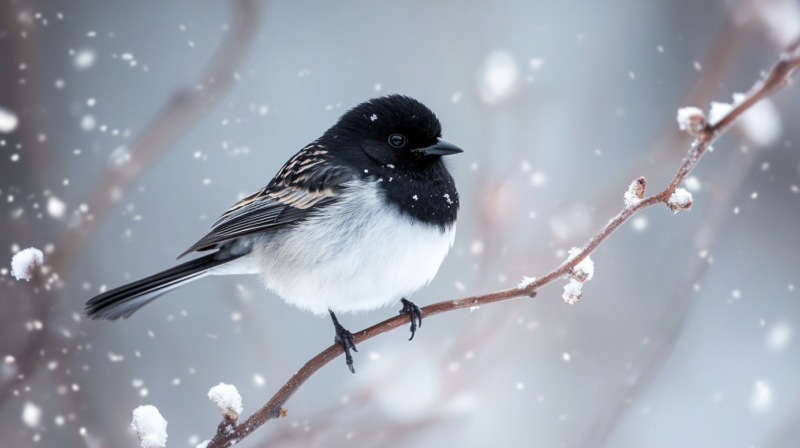
Dark-eyed Juncos are small, round, and easily recognizable birds, known for their smooth, grayish-black feathers and contrasting white belly.
One of their most distinctive features is the white flash from their tail feathers, which is especially noticeable when they fly.
These birds are common throughout Virginia, particularly during the colder months, earning them the nickname “snowbirds” because they often appear in residential areas and backyards in winter.
During the breeding season, they are typically found in coniferous and mixed forests at higher elevations, where they nest on or near the ground, often tucked into grasses or among shrubs.
Juncos feed primarily on seeds, but they switch to insects like beetles, caterpillars, and spiders when raising their young.
They are ground foragers, scratching through leaf litter to find food, and are frequently seen hopping around in flocks.
Males sing a bright, trilling song to establish territory and attract mates, while softer warbling calls can be heard during social interactions.
Trait
Description
Scientific Name
Junco hyemalis
Size
5-6 inches (13-16 cm)
Wingspan
7-9 inches (18-23 cm)
Diet
Seeds, insects
Habitat
Coniferous forests, residential areas, gardens
Song
Bright, trilling song
Lifespan
Up to 11 years
Conservation Status
Least Concern
6. Turkey Vulture (Cathartes aura)
The Turkey Vulture is one of the most commonly seen large black birds in Virginia.
These scavengers are easily identified by their dark blackish-brown body, distinctive bald red head, and broad wings that appear to hold a shallow “V” shape when soaring.
Often seen gliding in circles high in the sky, they are masters of utilizing thermal air currents to stay aloft with minimal effort.
Turkey Vultures primarily feed on carrion and use their highly developed sense of smell to detect dead animals from miles away.
They are often seen near roadkill or in open areas where they can easily spot carcasses. In addition to their unique foraging habits, they have an unusual way of cooling down—by defecating on their legs, which helps to reduce body temperature.
Their nesting sites are typically in caves, hollow logs, or abandoned buildings where they lay 1-3 eggs directly on the ground.
Both parents take turns incubating the eggs, which hatch after about 30-40 days.
Fledging occurs after roughly 70-80 days, but young vultures may continue to rely on parents for some time after leaving the nest.
Trait
Description
Scientific Name
Cathartes aura
Size
24-32 inches (62-81 cm)
Wingspan
5-6 feet (1.5-1.8 m)
Diet
Carrion
Habitat
Open woodlands, fields, grasslands
Song
Hissing and grunting
Lifespan
Up to 20 years
Conservation Status
Least Concern
7. American Crow (Corvus brachyrhynchos)
American Crows are large, glossy black birds with strong bills and legs, and they are incredibly adaptable to various habitats across Virginia.
Their plumage often has a subtle iridescent sheen, giving it a purplish or greenish tint in the sunlight. Highly social and intelligent, crows are known for their complex vocalizations, including the familiar “caw-caw” and a range of rattles, clicks, and even mimicry.
They are extremely versatile in their diet, feeding on anything from insects and small mammals to fruits, grains, garbage, and even carrion. Crows are also known to raid other birds’ nests for eggs and chicks.
These birds are often seen in urban areas, farmlands, woodlands, and even cemeteries. They build large stick nests high in trees where both males and females participate in raising the young.
Family groups often stay together throughout the year, and young crows may remain with their parents for several seasons.
Known for their problem-solving skills and the ability to use tools, crows are fascinating both in behavior and intelligence.
Trait
Description
Scientific Name
Corvus brachyrhynchos
Size
16-21 inches (40-53 cm)
Wingspan
33-40 inches (84-100 cm)
Diet
Omnivorous (insects, seeds, carrion, garbage)
Habitat
Woodlands, urban areas, farmlands, parks
Song
Loud “caw-caw”
Lifespan
Up to 15 years
Conservation Status
Least Concern
8. Double-crested Cormorant (Nannopterum auritum)
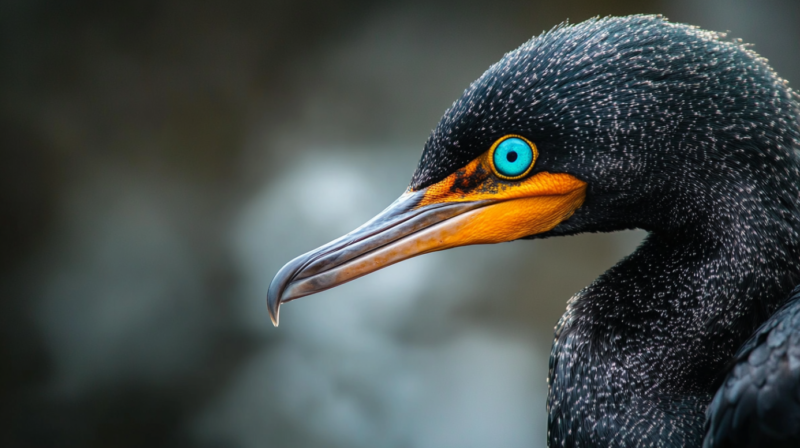
Double-crested Cormorants are large, dark waterbirds commonly seen near lakes, rivers, and coastal areas throughout Virginia.
They have a sleek, black body with a long neck and a hooked bill, and during breeding, they develop double crests of black or white feathers on their heads.
Unlike most waterbirds, their feathers are not completely waterproof, so they are often seen perched with wings spread wide to dry.
They are excellent divers, swimming underwater to catch fish and other aquatic prey. Cormorants often nest in colonies on rocky islands or trees near water, where they construct bulky nests made from sticks and seaweed.
These nesting colonies can sometimes be so dense that their droppings kill vegetation. Both parents share incubation duties, which last about 28-30 days, and young fledge after about 35-42 days.
Trait
Description
Scientific Name
Nannopterum auritum
Size
28-35 inches (70-90 cm)
Wingspan
45-48 inches (114-122 cm)
Diet
Fish, crustaceans, aquatic insects
Habitat
Lakes, rivers, coastal areas
Song
Deep guttural grunts
Lifespan
Up to 20 years
Conservation Status
Least Concern
9. Common Grackle (Quiscalus quiscula)
Here’s a Common Grackle, Quiscalus quiscula, calling out. pic.twitter.com/Ua8OTOLWBn
— The Doctor (@Drstevenhobbs) May 7, 2023
Common Grackles are medium to large blackbirds known for their glossy, iridescent plumage that can display shades of purple, green, and bronze in the sunlight.
Their long, keel-shaped tails and piercing yellow eyes make them easy to identify, even among other blackbirds. Males tend to be more colorful and iridescent, while females are slightly duller but still exhibit a dark, glossy appearance.
Grackles are highly adaptable and can be found in a wide range of habitats, including open woodlands, marshes, urban parks, farms, and suburban areas. They often gather in large flocks, sometimes mixing with other blackbird species, forming massive congregations during migration and winter months.
Common Grackles are opportunistic feeders, eating almost anything they can find. Their diet includes insects, seeds, grains, small rodents, frogs, and even other birds’ eggs and nestlings. They are known for their habit of foraging on the ground or wading in shallow water to catch small aquatic creatures.
Grackles are also notorious for raiding crops, particularly cornfields, which makes them unpopular among farmers.
They can be seen using their strong bills to crack open acorns and other hard seeds.
During breeding season, males perform elaborate displays, puffing up their feathers and emitting harsh, metallic calls to attract mates. They build bulky nests from twigs and grasses, often lining them with mud. These nests are commonly placed in dense shrubs, tall trees, or even on structures in urban environments.
Females lay 4-6 eggs that hatch after about two weeks, and both parents participate in feeding the young. Grackles are known for their loud, rusty, creaking calls that can be heard from great distances.
Trait
Description
Scientific Name
Quiscalus quiscula
Size
11-13 inches (28-33 cm)
Wingspan
14-18 inches (36-46 cm)
Diet
Insects, grains, seeds, small animals
Habitat
Open woodlands, marshes, urban areas, farmlands
Song
Harsh, metallic “squeak” and creaking noises
Lifespan
Up to 20 years
Conservation Status
Least Concern
10. Boat-tailed Grackle (Quiscalus major)
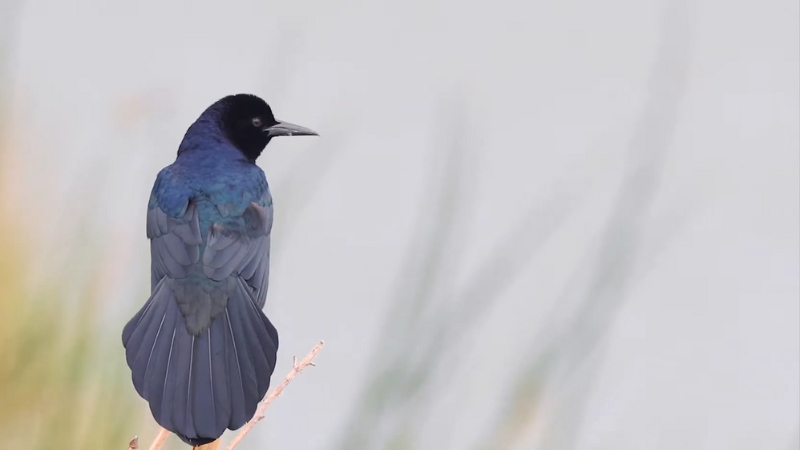
The Boat-tailed Grackle is a striking large blackbird that is commonly found along coastal regions of Virginia.
Males are glossy black with a shimmering iridescence, while females are significantly different, displaying a rich brown body with a darker head. One of the most distinctive features of the male is his long, deeply keeled tail that resembles the shape of a boat’s rudder, giving the species its name.
These birds are typically seen in marshes, coastal wetlands, and even in urban waterfront areas, where they gather in noisy, boisterous flocks.
Boat-tailed Grackles are highly social and are often seen feeding in groups. Their diet includes a wide range of foods, from seeds and grains to insects and small aquatic animals.
They are particularly skilled at scavenging and are not shy about approaching human activity, scavenging food scraps from outdoor dining areas or parking lots. In marshy habitats, they may also prey on small fish and crustaceans.
During breeding season, males establish territories and display aggressively to compete for mates, using their loud, harsh calls and puffed-up posture to assert dominance. Females build their nests in dense vegetation near water, using reeds and grasses to create a well-concealed structure.
They lay 3-5 eggs, which are incubated for about 13-15 days. Males often mate with multiple females, and fledglings leave the nest about two weeks after hatching.
Boat-tailed Grackles are known for their piercing, grating calls and complex vocal repertoire.
They are frequently seen roosting in large communal groups at night, creating a cacophony of sound. While they thrive in coastal areas, they have also adapted to urban environments, particularly near bodies of water.
You can discover more about the diverse wildlife by exploring the 26 most exciting animals at Nova Wild.
Trait
Description
Scientific Name
Quiscalus major
Size
15-17 inches (38-43 cm)
Wingspan
18-21 inches (46-53 cm)
Diet
Seeds, grains, insects, small fish, scraps
Habitat
Coastal marshes, wetlands, urban waterfronts
Song
Loud, harsh grating calls and chatter
Lifespan
Up to 12 years
Conservation Status
Least Concern
Related Posts:


